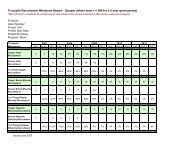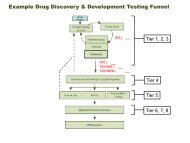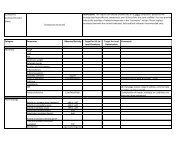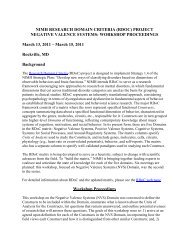Brain's Inner Workings: Teacher's Manual - NIMH
Brain's Inner Workings: Teacher's Manual - NIMH
Brain's Inner Workings: Teacher's Manual - NIMH
Create successful ePaper yourself
Turn your PDF publications into a flip-book with our unique Google optimized e-Paper software.
Extra Background<br />
Reviewing Neuron Ultrastructure<br />
Many students can benefit from a review of the<br />
structure of the highly differentiated neuron.<br />
The typical neuron is about 20 μm in diameter. Like<br />
most other cells, it has a nucleus that is about 5-10<br />
μm in diameter.<br />
Dendrites<br />
Cell Body<br />
Axon<br />
Myelin<br />
sheath<br />
In the cell, proteins are synthesized on ribosomes.<br />
Some float free in the cell; others are bound to the<br />
membranes of “rough” endoplasmic reticulum (ER).<br />
Both types of ribosomes are involved in protein<br />
synthesis, but the proteins that are destined to be bound to<br />
the cell membrane are normally produced on the rough ER.<br />
Image Source: http://www.nida.nih.gov/JSP4/MOD1/<br />
images/neuron1.gif<br />
The cytosol of neurons is especially rich in rough ER. (That’s what makes many neurons very reactive to the<br />
Nissl stain). That’s a clue that the production of membrane proteins and neurotransmitters is a key function<br />
in neurons. It’s a great example of structure providing clues to function. (Ask students: “If Nissl stain shows<br />
a great deal of rough endoplasmic reticulum, what does that suggest about the neuron’s metabolism?)<br />
Proteins that will eventually end up in the axon are further processed by the Golgi apparatus, since there is<br />
no protein synthesis in the cell processes. So Golgi are also notable in neuron ultrastructure.<br />
Neurons are high-energy cells, and accordingly have a high level of mitochondria. Relatively large microtubules<br />
run down the length of the cell helping it maintain its overall structure. A specific change to the<br />
microtubule-associated protein, Tau, is associated with the dementia that accompanies Alzheimer’s disease.<br />
Tau holds the microtubules in order; without it the shape of the dendrites change.<br />
Neurons can be classified by the general shape determined by their dendrites: pyramidal or stellate (star<br />
shaped). They can also be classified by their connections: sensory or motor; or classified by the neurotransmitter<br />
released by their synapses.<br />
But the most remarkable functions of neurons are directly associated with their membranes. That’s the<br />
content summarized in the Student Reading Membranes and Messages.<br />
12 The Brain’s <strong>Inner</strong> <strong>Workings</strong>: A Guide for Teachers<br />
Na t i o n a l Institute of Me n t a l He a l t h

















